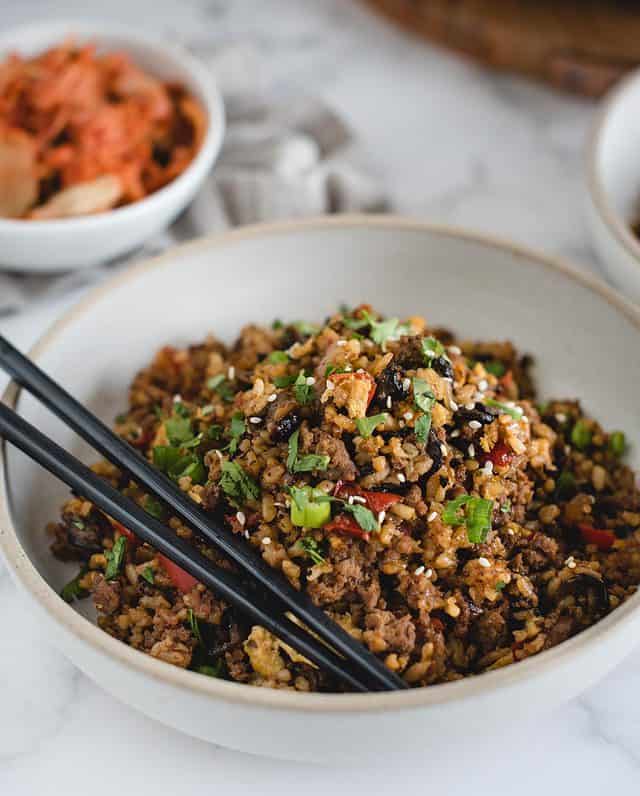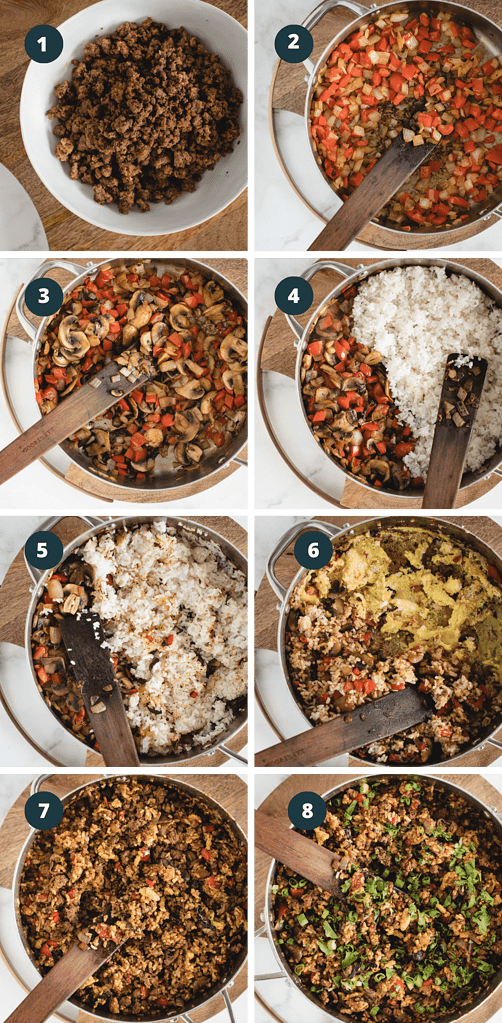This one-pan Korean Fried Rice recipe is loaded with ground beef, fresh veggies, fluffy rice, and egg tossed in a delicious Gochujang sauce. You will love the combination of flavors in every bowlful. It’s savory and umami with a hint of sweetness and a little punch of heat! You’ll have a fully-loaded, flavorful Korean meal that is better than any restaurant takeout, at your table in just 30 minutes. It is a protein-rich, filling dish that can be made gluten-free and is also perfect for meal prep since leftovers reheat great!

This recipe will take your day-old rice to new heights! This Korean-style fried rice has everything you need for a hearty lunch or dinner- from the savory beef, meaty mushrooms, crunchy peppers, rice, and scrambled eggs all doused in a soy-sesame gochujang sauce to give it Korean food flair.
You can enjoy it on its own, or as a side paired with Thai stuffed peppers or another delicious main dish. You can also use this as a filling for guchujang lettuce wraps. If you are looking for more tasty rice dishes, try my Thai fried brown rice and mushroom brown rice pilaf.

A fully-loaded yet easy meal
Keep this quick and easy satisfying recipe in your back pocket for those hectic weekday meals we all have and need. This one-pan Gochujang Korean fried rice has all the elements you need for a compete meal.
You get carbs from the rice, protein from the beef, egg, and mushroom, and vitamins from the other vegetables mixed in. It keeps well in the fridge for several days so you can easily reheat leftovers for lunch the next day. To be able to make it even faster on weeknights, you can do the chopping up to 2 days in advance. Just store the vegetables and herbs in airtight containers in the refrigerator.

Ingredients you need for gochujang Korean fried rice
This is the perfect dish to use up day-old rice or even leftover rice from takeout! The sauce is made of easy to find ingredients. Here’s the list of ingredients and possible substitutions:
- Oil– you can use sesame, avocado, or any other neutral flavored high-smoke point oil you like best.
- Ground beef– use 85% lean to get juicy, tasty beef that is not too greasy. You can use lean if you prefer (90-95%) but you may need to add more oil. If you prefer, you can use ground bison, ground turkey, chicken, pork, or pork belly chunks instead of beef but keep in mind you may need to adjust seasoning if making this swap.
- Vegetables– you will need red pepper, onion, mushrooms, cilantro, and green onions for this recipe. You can add or replace these with other veggies like green beans, peas, napa cabbage, cauliflower, broccoli, zucchini, bok choy, or spinach. If using longer cooking veggies like carrots, make sure to cut them thin so they cook as quickly as everything else.
- Eggs– add flavor and make the dish heartier and more filling.
- Rice– use up day-old cooked rice. In fact the rice NEEDS to be old and dry since fresh rice will just stick and not sear. I normally use leftover jasmine rice or another short-grain rice but medium-grain rice or even long-grain varieties like basmati work fine. Using brown rice adds extra nutrition too. because they cook up drier and are not mushy.
- Sesame seeds– for pops of nuttiness and crunch. You can use toasted sesame seeds to add a smoky undertone.

For the sauce:
- Ginger– freshly grated or just use prepared ginger in a jar to cut a few minutes out of your prep time.
- Garlic – as with the ginger, fresh is best but jarred garlic is fine too.
- Coconut sugar – you can also use coconut sugar or even honey or agave syrup to give it a deep, caramel-like sweetness.
- Soy sauce or reduced sodium tamari– adds that rich umami flavor. Using Tamari makes it gluten free and you can even substitute for coconut aminos if you prefer.
- Sesame oil– this authentic flavor and the oil helps with the overall texture of the dish. Use toasted sesame oil for a more pronounced flavor. If you don’t have sesame oil, substitute for avocado oil and if you don’t have that, just leave it out.
- Gochujang– this Korean fermented red chili paste adds a hint of spice and traditional Korean flavor. I only used 1 tablespoon of gochujang paste, but you can add more if you want it spicier. You used to have to go to Asian markets to find this but it’s at most local grocery stores now. The one I linked to is gluten-free but most brands aren’t so keep that in mind if you need that. If you don’t have it you can use some garlic chili sauce or another Asian hot sauce but might need to adjust the amount.
- Mirin– this rice wine is used various types of Asian dishes to add a touch of sweetness and depth of favor. If you don’t have it, you can substitute cooking sherry or another very dry white wine or leave it out.
How to make it
Once you have prepared all the ingredients, it will take only take you 20 minutes to cook this one pan Korean fried rice. This is a quick and easy recipe that you will make again and again for sure!
Preparations:
- Thaw the ground beef if frozen.
- Wash and chop the veggies.
- Whisk eggs together with a fork.
- Break up rice clumps with your hands until you they are loose and fluffy.
- Make the sauce by whisking all sauce ingredients together.
Steps for fried rice:
- Cook and season the beef in a large skillet over medium heat in a tablespoon of avocado oil, breaking it up as it cooks. Pour half of the sauce in to make sure each bite of beef is full of flavor! Remove beef and set aside.
- Sauté onions and bell peppers at increased medium-high heat.
- Add mushrooms and when they are done cooking, push to the side to make room for the rice.
- Cook the rice in more oil flipping it over after a few minutes to get it nice and crispy
- Break the rice up and stir in with the veggies, pushing over to the side to make room for the eggs.
- Add the eggs and let them cook before breaking up into pieces and stirring into the rice mixture.
- Add the cooked beef and remaining sauce and stir to let the flavors meld.
- Garnish each finished dish top with cilantro, green onion, and sesame seeds, and serve immediately.

Variations for Korean fried rice
- Use Kimchi. Kimchi fried rice is an authentic recipe you’ll find in Korean restaurants. I find the tangy flavor it adds absolutely delicious and I’m not even a huge kimchi lover! Add store-bought kimchi (or homemade!) while cooking or on top when serving. To add when cooking, drain kimchi juice and stir kimchi into vegetables during the last minute of cook time before pushing it to the side of the skillet to add the rice.
- Try it with a sunny side up fried egg to the top of the rice. Skip the scramble step.
- Make it kid-friendly. if your child is a picky eater, you can chop the veggies smaller so they won’t notice them or just use whatever veggies they prefer. My daughter likes it with pineapple and carrot! Also reduce the amount of Korean chili paste to make it less spicy and just add chili crisp oil, siracha, or Gochugaru (Korean chili pepper flakes) to your portion if you’re craving extra heat.
- Gluten-free. To make gluten-free, make sure to use a gluten-free gochujang and Tamari instead of soy sauce
- Make it vegetarian. You can omit beef to make it vegetarian and leave out the egg too for vegan. If you do this, half of the sauce to the vegetables when they’re done with their initial sear to make them more flavorful.
- Oyster sauce added to the sauce will give it more of a sweet umami boost (2 teaspoons should be plenty).
- Seaweed strips sprinkled to the top of each serving are a great way to add extra flavor and nutrition.

- Since this is a quick stir-fry recipe, make sure all the ingredients are prepared and within reaching distance before you start cooking. You will not have time to chop or measure once the pan is heated.
- The oil has been enough every time I’ve made this but some pans will cause more sticking. If your rice is sticking to the bottom of the pan, you may need to add more oil to get a good fried rice texture. You can also use a spatula with a thinner edge for scraping and flipping the rice.
- Rice has to be from the previous day and dry, not mushy. Cold rice makes the best fried rice, just make sure to break up any clumps. Fresh rice is too sticky and won’t get crispy.
- Make sure to let the beef sit undisturbed for a few minutes before breaking up it ensure it browns properly.
- Using a large skillet or wok is important since it gives more surface area for the ingredients to sear instead of steaming. This is how you get that extra flavor from caramelization.
Storage
Once the Gochujang fried rice has cooled down, you can transfer it to an airtight container. You can keep it stored in the fridge for 3 to 4 days, reheating leftovers in the microwave or stovetop in a pan with a little bit of oil. You can sprinkle a little bit of water on top to revive it if the rice has become too dry.
It freezes well too! If freezing, use a freezer safe container with most of the air removed. Store in the freezer for up to a month. To reheat, thaw overnight in the fridge and then heat in the microwave or stovetop. It isn’t the same as fresh but holds up surprisingly well after freezing.

Ingredients
- 2 Tbsp. sesame or avocado oil
- 1 lb. lean ground beef 85% lean preferably
- 1 red pepper diced
- 1 onion diced
- 8 oz. mushrooms sliced
- 2 eggs
- ¼ cup chopped cilantro
- ¼ cup sliced green onion
- 3 cups day old cold cooked rice with any rice clumps broken up into smaller pieces rice should be drier texture, not mushy
- 1 teaspoon sesame seeds
Sauce
- 1 tsp. minced ginger
- 2 tsp. minced garlic
- 3 T packed coconut sugar or brown sugar
- 1/3 cup reduced sodium soy sauce or tamari
- 1 tsp. sesame oil
- 1 Tbsp. gochujang or more if you want it spicier
- 1 Tbsp. mirin
Instructions
- Add all sauce ingredients into a medium sized bowl and whisk together until mixed. Set aside.
- In another small bowl, whisk eggs together with a fork. Set aside.
- In a large skillet over medium heat, add 1 Tbsp. avocado oil.
- When oil is warm, add beef and brown, breaking it up with a spatula into small pieces as it cooks.
- Once beef is browned, add about half of the sauce and stir in as the beef finishes cooking.
- Remove beef from skillet into a bowl and set aside. Leave 1-2 Tbsp. of leftover fat from the beef in the pan if there is any, otherwise, add additional 1 Tbsp. avocado oil.
- Increase heat to medium-high. Add red pepper and onion to skillet and cook for 2-3 minutes until starting to brown. Add mushrooms and cook another 2-3 minutes until all vegetables are lightly browned.
- Push vegetables to one side of the skillet and add 1 tablespoon sesame or avocado oil to empty space.
- Add rice and let sear for 2-3 minutes. Use spatula to flip rice over and sear for another 2-3 minutes on the other side. If rice is sticking, add more oil. Break the rice clumps up and continue cooking, letting it sear for 30 seconds to a minute in between stirring to allow rice to brown.
- Once rice has browned somewhat, stir in with veggies and push mixture off to one side of the skillet. Pour egg in to the open space and let it cook for 1-2 minutes, flip and then let other side cook until it starts to scramble. Break egg into pieces and stir into rice/veggie mixture on side of skillet.
- Add cooked beef and remaining sauce to skillet. Stir to combine and cook for an additional minute.
- Remove from heat, top with cilantro, green onion and sesame seeds and serve immediately. We like to serve with Kimchi but its delicious on it's own!
Video
Notes
-
- Gluten free: make sure to use gluten free gochujang and tamari instead of soy sauce.
- Prep: can be done up to 2 days in advance: make the rice (necessary to do at least one day ahead), make the sauce, and chop the vegetables and herbs and store in airtight containers in the refrigerator.
- Storage: refrigerate in an airtight container for up to 4 days in the refrigerator. Reheat in the microwave or in a skillet on the stovetop with a little bit of oil. Sprinkle a little bit of water on top if the rice has become too dry.
- Freezing: cool completely before placing in a freezer safe container with most of the air removed. Store in the freezer for up to a month. To reheat, thaw overnight in the fridge and then heat in the microwave or in a skillet on the stovetop, adding additional oil and a splash of soy sauce if necessary.
- Rice sticking: if rice sticks the bottom of the pan, add more oil. You can also use a spatula with a thinner edge for scraping and flipping the rice.
-
- Rice: has to be old and dry to become crispy. Cold rice works best.
Nutrition
did you make this recipe?
Make sure to follow on Pinterest @feastingnotfasting and on Instagram @feastingnotfasting












Comments & Reviews
This was delicious! 🙂
The best use for old rice on the planet!